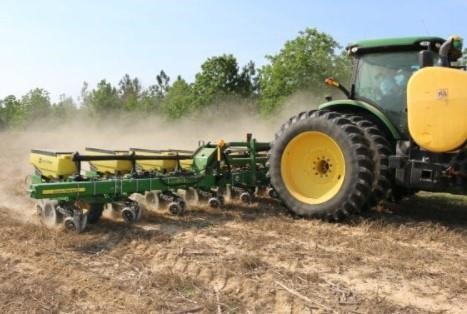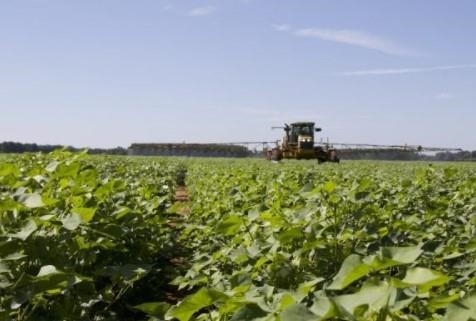“Good production, good prices and good management are keys to making the most of any cotton crop,” Brown said. “This year comes with added pressure and challenges.”
Brown said the excitement of profitable pricing is hindered by obvious global challenges, but the Extension agronomic crops team is working to help producers make sound management decisions.

Production
“There is no substitute for yield,” Brown said. “We cannot be profitable apart from good yields. Likewise, we need to capitalize on current market opportunities.”
Contracting a portion of the farm’s expected bales in the current price range is prudent. Brown said this is better done sooner than later, as markets characteristically do not like issues like the Russian invasion of Ukraine.
Timeliness
“Proper timing maximizes the efficacy and value of each and every input,” Brown said.
For example, a foliar spray of acephate for thrips when there is obvious damage—at the two- to three-leaf stage—is far less effective than a spray three to six days earlier on cotyledon to one-leaf cotton when thrips first appear in the terminal.
The expenditure amount is the same, but the outcomes are very different. Brown said the most important management input this season may be timeliness.
Reductions
As cost management becomes necessary because of climbing input prices, Brown hopes producers will consider two options: reduced seeding rates and adjusted fertilizer inputs.
“Research encourages a consideration of seeding rate reductions,” Brown said. “A global review of cotton seeding rate experiments determined that a final plant population of just over 14,000 plants per acre is sufficient for normal yields.”
Researchers from Arkansas recently concluded that a threshold of slightly more than one plant per foot was sufficient for maximum yields. Brown said this was not a suggestion to plan less than two seed per foot, but an encouragement to consider a seeding rate reduction if rates exceed 35,000 seed per acre.
Other reductions could include a heavily managed fertilizer regimen. Soil tests are essential, but especially when it comes to making management decisions in 2022.
“If phosphorus levels are very high, maybe producers can cut back,” Brown said. “Nitrogen is of particular concern, given its cost and overall importance in growth.”
Excessive nitrogen rates waste money, but also create problems with foliar diseases, hard lock, boll rot, crop maturity and defoliation. Ongoing research continues to support a nitrogen rate of 90 pounds per acre, sometimes less.
Nitrogen Replacement Options
As nitrogen prices soar, many growers are turning their attention to alternative, less expensive nitrogen sources.
Rishi Prasad, an Alabama Extension nutrient management specialist, said although there is plenty of available broiler litter in Alabama, row crop producers need to understand that litter is a slow-release nutrient source.
“It is a good starter fertilizer that supplies several nutrients in the early stages of the crop,” Prasad said. “However, producers should not rely solely on litter to provide all of the nitrogen needs for cotton.”
Prasad addresses other common chicken litter questions in the most recent issue of Alabama Cotton Shorts, a newsletter for cotton farmers by Alabama Extension agents and specialists. Find information on the effectiveness of broiler litter as a nitrogen fertilizer source, as well as additional crop management information.
Herbicide Supply Issues

Anticipation of the lack of herbicide availability has overshadowed the 2022 growing season since late 2021.
In late February, Bayer announced a force majeure decision—a French term indicating contractual actions compelled by unforeseeable circumstances—because of mechanical failures in a Louisiana manufacturing plant that provides key raw materials.
Steve Li, an Alabama Extension weed scientist, said the anticipated repair will take three months and will undoubtedly further affect glyphosate supply and pricing.
“In prior months, limited supplies have significantly increased grower price for the herbicide,” Li said. “Name brand Roundup Powermax is currently more than $50 per gallon, and this latest news may further increase prices.”
Supply levels of other commonly-used burndown herbicides–such as glufosinate, paraquat and generic 2,4-D–are also tight and unpredictable. Li said glufosinate and generic 2,4-D prices have more than doubled compared to last season.
“Chemical dealers can still lock chemical prices with new orders,” Li said. “However, no one can predict delivery dates which is obviously a major concern. What if crop protection products ordered in January or February still do not show up by May 1? What if they are delivered at the end of August? Producers are facing very uncertain circumstances right now and through the growing season.”
There are many clethodim formulations and generic products currently on the market. Since there are many generic formulations with different concentrations, it is important to read the label before making rate decisions. Read more in the Feb. 22 issue of Alabama Cotton Shorts.
Source : aces.edu